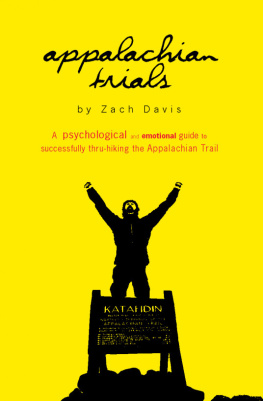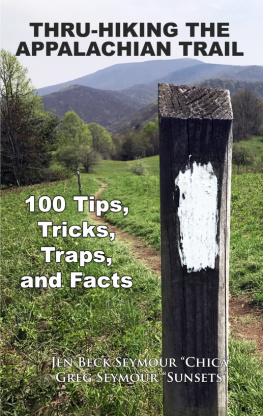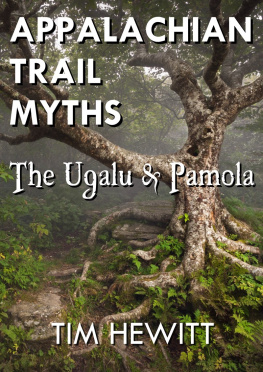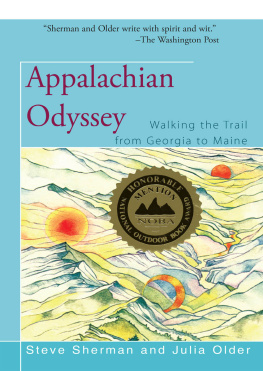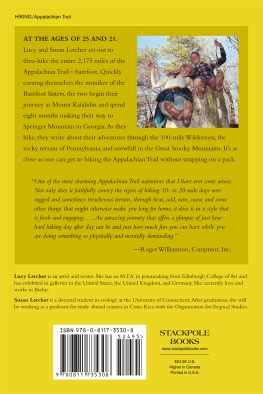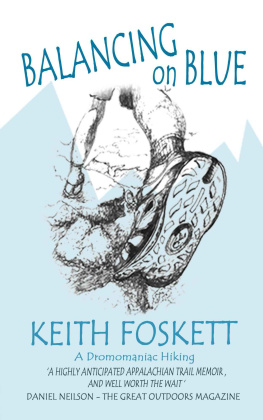Advance Praise
In 2005, Diane Harsha strapped on a pack and took her first steps on the Appalachian Trail at Springer Mountain, Georgia. She completed her 2,200- mile odyssey atop Mount Katahdin, Maine, thirteen years later. With humor and unvarnished honesty, she tells us how she carried out her quest, section by section, to hike the AT while also fulfilling her roles as wife, mother, and FBI agentproving we dont have to put off our dreams until we have the time to pursue them. Sometimes solo and sometimes accompanied by Smokin Goat, Kim Commando, She Who Falls A Lot, or other strong, colorful women, Sticks (as she became known) encounters bears, rattlesnakes, unfriendly Bubbas, storms, and other dangers that threaten to derail her plans. But always, the beauty of the AT that she writes of so reverently calls on her to strap on her pack and tackle the next challenge. Whether you have also answered the call of the wild or prefer to live it vicariously, youll find much to laugh about and love in this delightful coming - of - middle - age memo ir.
Gerald D. Swick, author of the West Virginia Histories series
Few of us have the imagination, fortitude, courage, or pluck to tackle a 2,200 mile hike. But the intrepid Diane Sticks Harsha is not most of us. For thirteen years, she entwined her life with the Appalachian Trail. Now, she offers an enthralling memoir that transports us across dramatically beautiful landscapes, through ever - changing weather, into triumph and despair, enlivened by memorable characters and quirky landing zones. As she crawls through sleet across New Hampshires White Mountains, your skin will sting and your knees ache. While she jokes about naturerolling in the aisles at (her) antics, we just marvel at her grit. A truly gifted writer with a talent for evocative phrasing, Sticks reminds us what being alive is truly all about. We may not share her admirable perseverance, but we can all revel in Sticks captivating sto ry.
Lesley Wischmann, author of Frontier Diplomats and This Far-off Wild Land
For 2,200 miles from Georgia to Maine, over mountains and into valleys, through forests and fields, we walk the entire length of the Appalachian Trail with Diane Sticks Harsha. She takes us with her on this finely written memoir, and the details put you right there with her throughout this amazing journey. We see, hear, and feel the rain, snow, hail, heat, bear, deer, snakes, and danger, and then suddenly, we are given glimpses into the soul of a hiker: In reality, these miles would reduce me to a ragged winter bone from which all the marrow had been sucked until even the hungriest dog would disdain it. Thats good writing! Go buy this book, then go home, sit down, and enjoy the hike with Stic ks.
George Spain, author of Lost Cove and Sundancing with Crazy Horse

Copyright 2021 Diane Sticks Ha rsha
All rights reser ved.
ISBN: 978-1-5445-22 07-4
This book is dedicated to all Angels, on and off the Tr ail.
This book is a memoir. The people, places, and events described are factual. However, some of the names of particular hikers have been changed in order to respect their privacy and the anonymity of the hiking commun ity.
Prologue
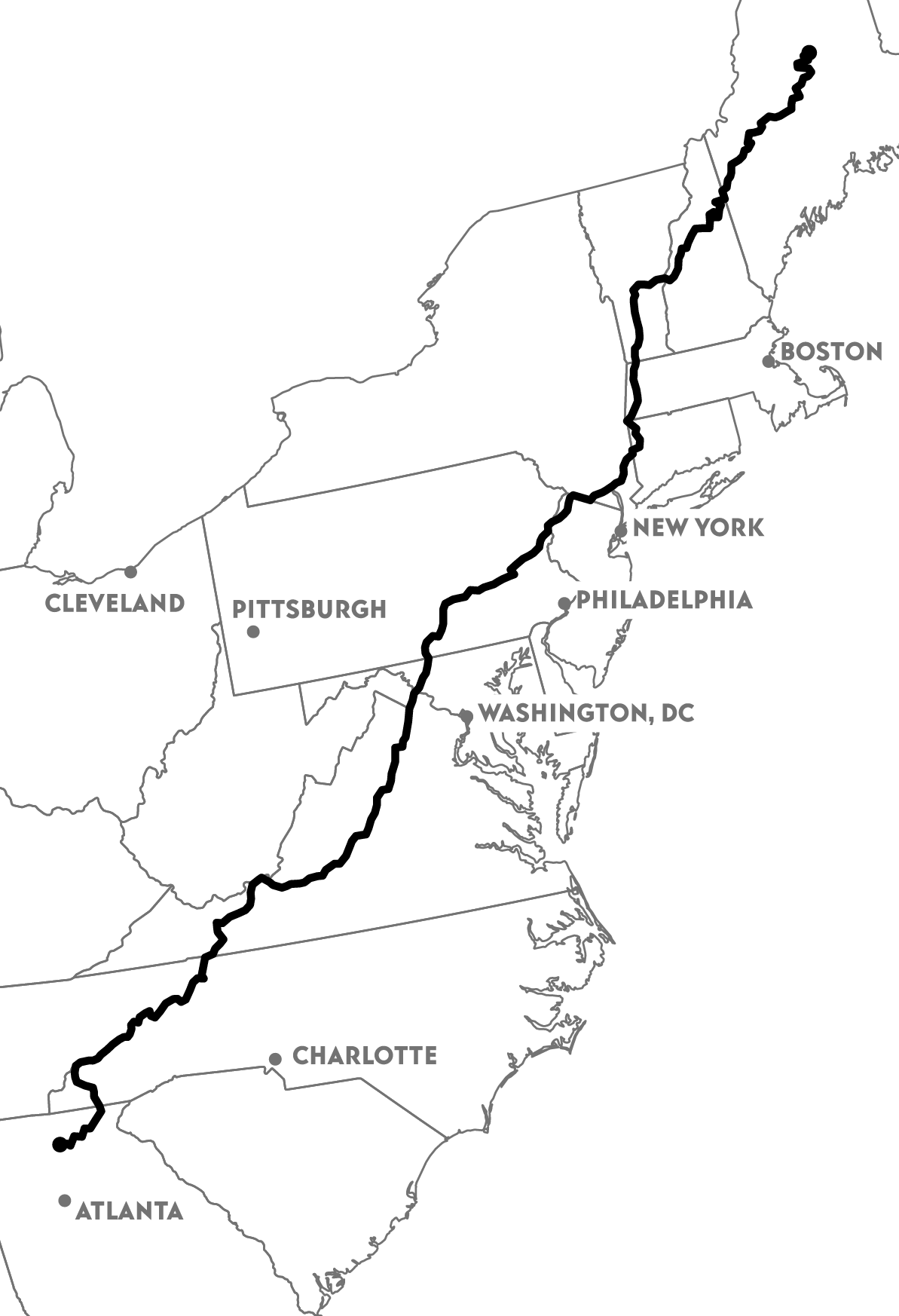
T he Appalachian Trail stretches for almost 2,200 miles from Springer Mountain, Georgia, to Mount Katahdin, Maine, along the spine of the mountain chain that gives this iconic footpath its name. The path, as a rule, is about eighteen inches wide, lined with fragrant pine needles and musky fallen leaves, bordered by clingy bramble bushes or the jade - green leaves of laurel and rhododendron, meandering up and down, switchback by switchback, under a canopy of hardwoods and evergreens. It is marked with four - by - six - inch white blazes painted on trees every fifty feet or so. But the many exceptions to these rules give the Trail its appealing diversity and its maddening challen ges.
Sometimes the path widens along old foresting roads or narrows to crevices between boulders, it often crosses rivers and streams without benefit of bridges or stepping stones, and occasionally it marches itself right down through the middle of a small town. It goes through tunnels, over bridges, and along highway overpasses. It winds its way through state parks, national parks, city parks, and privately owned lands. It traverses or skirts meadows, cow pastures, and fields of cropscorn, barley, soybeanscultivated in the eastern United Sta tes.
The mountains themselves consist of rolling hills, craggy peaks, and sunny balds. At the southern end of the AT, the Smoky Mountains are covered in dense forest, and at the northern end, the White Mountains rise up above tree line as great slabs of granite. The change in elevation along the Trail is over 460,000 feet, and if you have walked the entire length, you have climbed the equivalent of sixteen Mount Evere sts.
The four - by - six - inch white blaze can be found on trees, rocks, sidewalks, telephone poles, road signs, and bridge railings. As the AT crosses meadows and fields, posts have been set into the ground at steady intervals for the sole purpose of bearing a blaze to guide the hiker. There is a blaze painted on the bottom of the rowboat which ferries hikers across the Kennebec River in Maine to verify the authenticity of this method of crossing the dangerous wat ers.
For over two thousand miles, the Appalachian Trail constantly contradicts itself. It is brazen but respectful, remote yet accessible, harsh and then forgiving. There are few rules on the AT other than universal camping or hiking etiquette, and there are no scorekeepers or officials. The Appalachian Trail Conservancy is a benevolent overseer, and dozens of hiking clubs staffed by hundreds of volunteers provide general upkeep and maintenance. The Trailwhile crafted by human hands and tended to with human heartsis a wild place, constantly on the precarious lip of returning to nat ure.
It attracts thousands of visitors annually, and most of those will hike for only a few hours or a day. Of those who attempt a thru - hike (the entire Trail in one hiking season, usually four to six months), only one in four of those will complete the trek. Those who do will tell you it was the best time of their lives and the hard est.
Then there are the section hikers. We are those who, periodically and sporadically, hike over a stretch of time and milesa weekend here, a week there, twenty, fifty, a hundred miles. My journey began on a September weekend in 2005 at Springer Mountain, Georgia, and ended on a September weekend in 2017 at Mount Katahdin, Maine. For thirteen years, I had one foot on the Trail and one foot offmy heart always in two places. But this was a blessing and a gift, a pleasure doubled rather than hal ved.
***
Over those years, whenever my mind called for peace, when sleep would not come, when worries of work or family troubled me, my thoughts turned to the hike. I saw the narrow soft trail under my boots, rising and falling with my breath. I smelled the sharp clean pine needles and heard the small animals scuffle away at my approach. I felt the heaviness of my pack and the sweet relief of rest. The utter simplicity of hikingeat what you have, drink when you can, sleep when its dark, follow the blazecalled to me and I would go.



